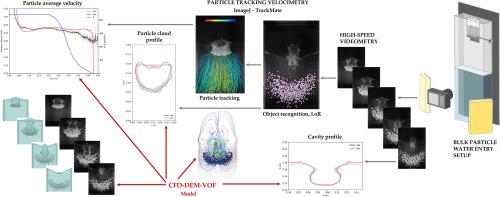当前位置:
X-MOL 学术
›
Particuology
›
论文详情
Our official English website, www.x-mol.net, welcomes your feedback! (Note: you will need to create a separate account there.)
Analysis of particle dispersion and cavity formation during bulk particle water entry using fully coupled CFD-DEM-VOF approach
Particuology ( IF 3.5 ) Pub Date : 2024-01-22 , DOI: 10.1016/j.partic.2023.12.018 Utkan Çalışkan , Sanja Mišković
Particuology ( IF 3.5 ) Pub Date : 2024-01-22 , DOI: 10.1016/j.partic.2023.12.018 Utkan Çalışkan , Sanja Mišković

|
This paper presents the development and validation of a fully coupled computational fluid dynamics—discrete element method—volume of fluid (CFD-DEM-VOF) model to simulate the complex behavior of particle-laden flows with free surfaces. The coupling between the fluid and particle phases is established through the implemented continuity, momentum, and alpha transport equation. The coupled particle forces such as drag, pressure gradient, dense virtual mass, viscous, and interface forces are also integrated, with drag and dense virtual mass forces being dependent on local porosity. The integrated conservative alpha transport equation ensures phase volume conservation during interactions between particles and water. Additionally, we have implemented a trilinear interpolation method designed to operate on unstructured hexahedral meshes. This method has been tested for its ability to properly resolve the coupling effects in the numerical simulations, particularly in cases with a relatively low cell-size ratio. The model is validated through three distinct test cases: single particle water entry, dam break with particles, and water entry of a group of particles case. The experimental setup is built to study the dynamics of the water entry of a group of particles, where three key flow features are analyzed: the evolution of average particle velocity, cavity shape, and particle dispersion cloud profiles in water. The tests involve four different scenarios, including two different water levels (16.1 and 20.1 cm) and two different particle densities (2650 and 4000 kg/m). High-speed videometry and particle tracking velocimetry (using ImageJ/TrackMate) methods are employed for experimental data acquisition. It is demonstrated that numerical results are in excellent agreement with theoretical predictions and experimental data. The study highlights the significance of vortices in cavity shaping and particle dispersion. The validated CFD-DEM-VOF model constitutes a robust tool for simulating particle-laden flows, contributing valuable insights into the complex interplay between particles and fluids.
中文翻译:

使用全耦合 CFD-DEM-VOF 方法分析散装颗粒入水过程中的颗粒分散和空腔形成
本文介绍了完全耦合计算流体动力学 - 离散元法 - 流体体积 (CFD-DEM-VOF) 模型的开发和验证,以模拟具有自由表面的颗粒负载流的复杂行为。流体相和颗粒相之间的耦合是通过实施的连续性、动量和 α 输运方程建立的。耦合粒子力(例如阻力、压力梯度、致密虚拟质量、粘性和界面力)也被积分,其中阻力和致密虚拟质量力取决于局部孔隙率。集成的保守 α 输运方程确保了颗粒与水相互作用期间相体积守恒。此外,我们还实现了一种三线性插值方法,旨在对非结构化六面体网格进行操作。该方法已经过测试,能够正确解决数值模拟中的耦合效应,特别是在单元尺寸比相对较低的情况下。该模型通过三个不同的测试案例进行验证:单颗粒入水、颗粒溃坝以及一组颗粒入水案例。该实验装置旨在研究一组颗粒进入水的动力学,其中分析了三个关键的流动特征:平均颗粒速度、空腔形状和水中颗粒分散云轮廓的演变。测试涉及四种不同的场景,包括两种不同的水位(16.1 和 20.1 cm)和两种不同的颗粒密度(2650 和 4000 kg/m)。采用高速视频测量和粒子跟踪测速(使用 ImageJ/TrackMate)方法进行实验数据采集。结果表明,数值结果与理论预测和实验数据非常吻合。该研究强调了涡流在空腔成型和颗粒分散中的重要性。经过验证的 CFD-DEM-VOF 模型构成了模拟颗粒负载流的强大工具,为了解颗粒和流体之间的复杂相互作用提供了宝贵的见解。
更新日期:2024-01-22
中文翻译:

使用全耦合 CFD-DEM-VOF 方法分析散装颗粒入水过程中的颗粒分散和空腔形成
本文介绍了完全耦合计算流体动力学 - 离散元法 - 流体体积 (CFD-DEM-VOF) 模型的开发和验证,以模拟具有自由表面的颗粒负载流的复杂行为。流体相和颗粒相之间的耦合是通过实施的连续性、动量和 α 输运方程建立的。耦合粒子力(例如阻力、压力梯度、致密虚拟质量、粘性和界面力)也被积分,其中阻力和致密虚拟质量力取决于局部孔隙率。集成的保守 α 输运方程确保了颗粒与水相互作用期间相体积守恒。此外,我们还实现了一种三线性插值方法,旨在对非结构化六面体网格进行操作。该方法已经过测试,能够正确解决数值模拟中的耦合效应,特别是在单元尺寸比相对较低的情况下。该模型通过三个不同的测试案例进行验证:单颗粒入水、颗粒溃坝以及一组颗粒入水案例。该实验装置旨在研究一组颗粒进入水的动力学,其中分析了三个关键的流动特征:平均颗粒速度、空腔形状和水中颗粒分散云轮廓的演变。测试涉及四种不同的场景,包括两种不同的水位(16.1 和 20.1 cm)和两种不同的颗粒密度(2650 和 4000 kg/m)。采用高速视频测量和粒子跟踪测速(使用 ImageJ/TrackMate)方法进行实验数据采集。结果表明,数值结果与理论预测和实验数据非常吻合。该研究强调了涡流在空腔成型和颗粒分散中的重要性。经过验证的 CFD-DEM-VOF 模型构成了模拟颗粒负载流的强大工具,为了解颗粒和流体之间的复杂相互作用提供了宝贵的见解。



























 京公网安备 11010802027423号
京公网安备 11010802027423号